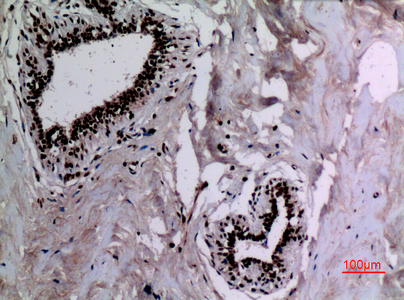HSP 90 (Acetyl Lys292/284) Polyclonal Antibody
- Catalog No.:YK0029
- Applications:WB;IHC;IF;ELISA
- Reactivity:Human;Mouse;Rat
- Target:
- HSP 90
- Fields:
- >>Protein processing in endoplasmic reticulum;>>PI3K-Akt signaling pathway;>>Necroptosis;>>Antigen processing and presentation;>>NOD-like receptor signaling pathway;>>IL-17 signaling pathway;>>Th17 cell differentiation;>>Progesterone-mediated oocyte maturation;>>Estrogen signaling pathway;>>Salmonella infection;>>Pathways in cancer;>>Chemical carcinogenesis - receptor activation;>>Prostate cancer;>>Lipid and atherosclerosis;>>Fluid shear stress and atherosclerosis
- Gene Name:
- HSP90AA1/HSP90AB1
- Protein Name:
- Heat shock protein HSP 90-alpha/Heat shock protein HSP 90-beta
- Human Gene Id:
- 3326
- Human Swiss Prot No:
- P07900
- Mouse Gene Id:
- 15519
- Mouse Swiss Prot No:
- P07901
- Rat Gene Id:
- 299331
- Rat Swiss Prot No:
- P82995
- Immunogen:
- The antiserum was produced against synthesized Acetyl-peptide derived from human HSP90A/B around the Acetylation site of Lys292/284. AA range:251-300
- Specificity:
- Acetyl-HSP 90 (K292/284) Polyclonal Antibody detects endogenous levels of HSP 90 protein only when acetylated at K292/284.
- Formulation:
- Liquid in PBS containing 50% glycerol, 0.5% BSA and 0.02% sodium azide.
- Source:
- Polyclonal, Rabbit,IgG
- Dilution:
- WB 1:500 - 1:2000. IHC: 1:100-300 ELISA: 1:20000.. IF 1:50-200
- Purification:
- The antibody was affinity-purified from rabbit antiserum by affinity-chromatography using epitope-specific immunogen.
- Concentration:
- 1 mg/ml
- Storage Stability:
- -15°C to -25°C/1 year(Do not lower than -25°C)
- Other Name:
- HSP90AA1;HSP90A;HSPC1;HSPCA;Heat shock protein HSP 90-alpha;Heat shock 86 kDa;HSP 86;HSP86;Renal carcinoma antigen NY-REN-38;HSP90AB1;HSP90B;HSPC2;HSPCB;Heat shock protein HSP 90-beta;HSP 90;Heat shock 84 kDa;HSP 84;HSP84
- Observed Band(KD):
- 85kD
- Background:
- The protein encoded by this gene is an inducible molecular chaperone that functions as a homodimer. The encoded protein aids in the proper folding of specific target proteins by use of an ATPase activity that is modulated by co-chaperones. Two transcript variants encoding different isoforms have been found for this gene. [provided by RefSeq, Jan 2012],
- Function:
- caution:Despite classification as a pseudogene, the existence of this protein is supported by unambiguous mass spectrometry evidence.,function:Molecular chaperone.,function:Molecular chaperone. Has ATPase activity.,similarity:Belongs to the heat shock protein 90 family.,subcellular location:Identified by mass spectrometry in melanosome fractions from stage I to stage IV.,subunit:Homodimer. Interacts with AHSA1, SMYD3 and TOM34. Interacts with FNIP1 and HSF1.,
- Subcellular Location:
- Nucleus . Cytoplasm . Melanosome . Cell membrane . Mitochondrion . Identified by mass spectrometry in melanosome fractions from stage I to stage IV.
- Expression:
- Adult brain,Brain,Brain cortex,Breast,Cajal-Retzius
- June 19-2018
- WESTERN IMMUNOBLOTTING PROTOCOL
- June 19-2018
- IMMUNOHISTOCHEMISTRY-PARAFFIN PROTOCOL
- June 19-2018
- IMMUNOFLUORESCENCE PROTOCOL
- September 08-2020
- FLOW-CYTOMEYRT-PROTOCOL
- May 20-2022
- Cell-Based ELISA│解您多样本WB检测之困扰
- July 13-2018
- CELL-BASED-ELISA-PROTOCOL-FOR-ACETYL-PROTEIN
- July 13-2018
- CELL-BASED-ELISA-PROTOCOL-FOR-PHOSPHO-PROTEIN
- July 13-2018
- Antibody-FAQs
- Products Images
.jpg)
- Western Blot analysis of K562 cells using Acetyl-HSP 90 (K292/284) Polyclonal Antibody. Secondary antibody(catalog#:RS0002) was diluted at 1:20000
.jpg)
- Immunohistochemical analysis of paraffin-embedded human-breast, antibody was diluted at 1:100

- Immunohistochemical analysis of paraffin-embedded human-breast, antibody was diluted at 1:100
.jpg)
- Immunohistochemical analysis of paraffin-embedded human-brain, antibody was diluted at 1:100



